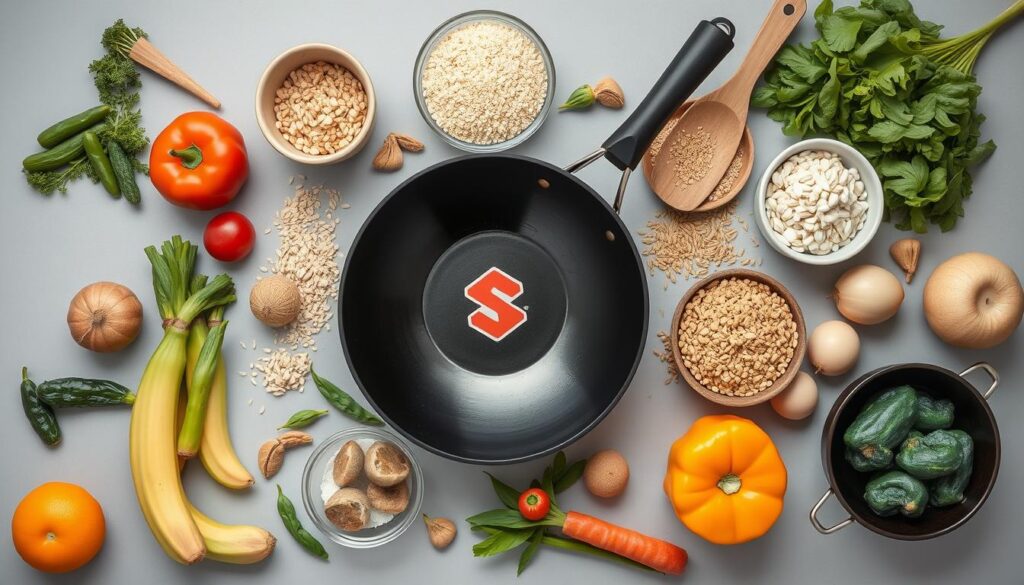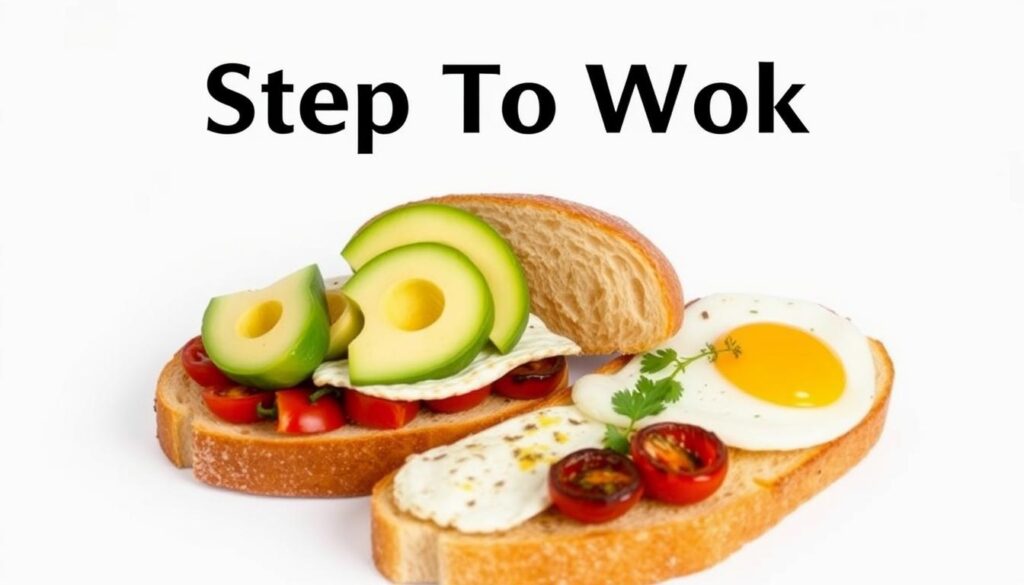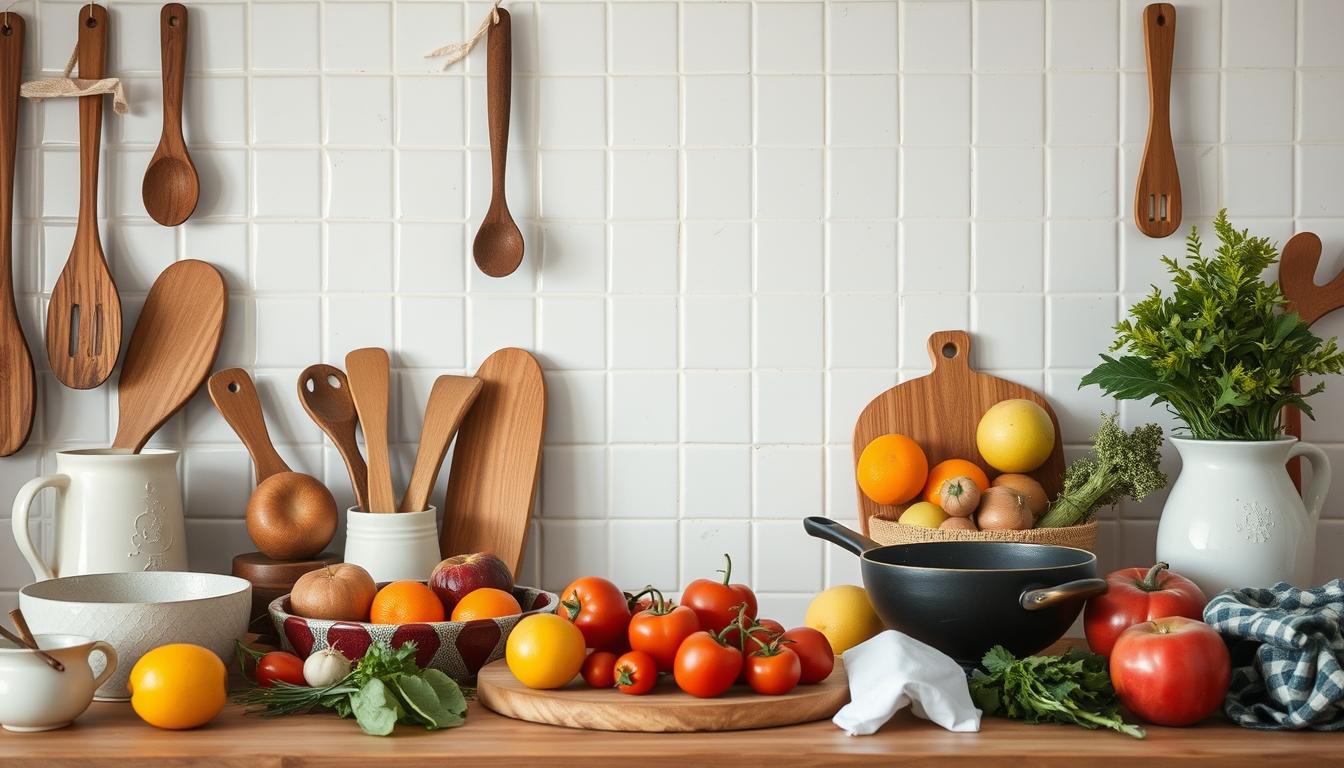Reducing food waste is key for a sustainable lifestyle. We can start by using leftovers to make tasty breakfasts. In the United States, up to 40% of food ends up in landfills. It’s important to use zero-waste recipes and anti-food waste practices in our cooking.
Exploring zero-waste breakfast recipes, we find creative ways to use leftovers. We can make scrambled eggs with leftover veggies or green goddess sauce from aging produce. These sustainable cooking tips and recipes help reduce waste. By adding zero-waste recipes to our mornings, we help the environment and support a sustainable food system.
Key Takeaways
- Up to 40% of food produced in the United States ends up in landfills, highlighting the need for zero-waste recipes and anti-food waste practices.
- Zero-waste breakfast recipes can help reduce food waste and promote sustainable cooking.
- Using up leftover ingredients can create delicious and sustainable breakfast meals.
- Embracing sustainable cooking practices can make a significant impact on reducing food waste.
- Zero-waste recipes can be easy to make and require minimal cooking time, making them perfect for busy mornings.
- By adopting zero-waste recipes, we can contribute to a more sustainable food system and reduce the amount of food that ends up in landfills.
The Importance of Zero-Waste Cooking
Reducing food waste is key for eco-friendly meals and sustainable living. Studies show that 30-40% of food in the U.S. goes uneaten. This shows we need zero-waste breakfast and anti-food waste ideas to lessen our environmental impact.
Starting zero-waste cooking can save up to 20% on groceries. Using scraps creatively can cut food waste by 30%. This makes cooking more sustainable and smart. By choosing eco-friendly meals and zero-waste breakfast ideas, we help the planet and save money.

Understanding Food Waste in America
Food waste in America is a big issue, with 60% coming from homes. Cutting down on waste can lower methane emissions and save kitchen time and money. By using anti-food waste ideas in meal planning, we help the environment and our wallets.
Benefits of Reducing Food Waste
Reducing food waste has many benefits. It lowers methane emissions, saves natural resources, and cuts costs. By practicing zero-waste cooking and choosing eco-friendly meals, we support a greener food system and eco-friendly living.
Creative Uses for Leftover Bread
Reducing food waste is key to a sustainable breakfast routine. You can turn leftover bread into tasty breakfast dishes. For example, you can make French toast, croutons, or bread pudding. These are all great zero-waste recipes.
Some favorite recipes include a fancy bread and butter pudding and a chocolate and banana fried bread sandwich. Both have high ratings. They not only cut down on food waste but also offer a tasty anti-food waste breakfast option.
Here are some tips for using leftover bread:
- Transform stale bread into French toast for a sweet breakfast treat
- Make croutons for your morning salad using leftover bread
- Create a bread pudding using leftover bread and a few simple ingredients

By using leftover bread in creative ways, you help the environment. You reduce food waste and live an anti-food waste lifestyle. With a bit of imagination, leftover bread can become many delicious breakfast dishes. This makes it simpler to follow a zero-waste cooking approach.
| Recipe | Average Rating | Preparation Time |
|---|---|---|
| French Toast | 4.5/5 | 10 minutes |
| Croutons | 4.2/5 | 5 minutes |
| Bread Pudding | 4.8/5 | 20 minutes |
Repurposing Overripe Fruits
Overripe fruits can be a challenge for many home cooks. But they also offer a chance to make delicious, eco-friendly meals. For instance, overripe bananas are perfect for smoothie bowls, a tasty zero-waste breakfast.
Every year, over 30% of the total food supply is wasted. Fruits and vegetables make up a big part of this. Using overripe fruits in our cooking can save 10-20% of grocery costs. Here are some ideas:
- Making fruit compote, a simple and delicious topping for yogurt or oatmeal
- Creating fruit ice cubes, which can add flavor and nutrition to plain water
- Using overripe fruits in baked goods, such as muffins or bread
These creative solutions help reduce food waste and promote sustainable cooking. By adding overripe fruits to our meals, we help the environment and our health. Exploring new ways to use overripe fruits can also introduce us to new flavors and textures.
Cooking with Leftover Vegetables
Cooking with leftover vegetables is a smart way to cut down on food waste. It’s known that about 20-30% of household food waste is leftover veggies. By using these leftovers, we can make tasty meals and help the planet.
Leftover vegetables are very versatile. For instance, frittatas can have up to 10 different veggies. This makes them perfect for using up leftovers and trying new zero-waste recipes. Also, breakfast burritos can have 3-5 ingredients like bell peppers, onions, and tomatoes. This helps us fight anti-food waste.
Veggie Scrambles to Kickstart Your Day
Veggie scrambles are a quick and tasty way to start your day. They can be made with many leftover veggies. Some favorites include:
- Spinach and tomato
- Bell peppers and onions
- Mushrooms and zucchini
These scrambles take less than 10 minutes to make. They’re ideal for busy mornings. By adding leftover veggies to our breakfasts, we can greatly reduce food waste and support sustainable cooking.
Utilizing Egg Yolks and Whites
Egg yolks and whites are great for making tasty breakfasts like quiches, omelets, and frittatas. They’re perfect for eco-friendly meals and reducing food waste. By using leftover eggs, we can make our meals more sustainable.
Egg whites can stay fresh in the fridge for up to 2 days or frozen for 3 months. Egg yolks also keep for 2 days in the fridge but might dry out. Knowing this helps us plan and waste less food.
Recipe Ideas for Leftover Egg Yolks
Leftover egg yolks are great for homemade custard, needing 1–5 yolks. For a richer carbonara, use 1–2 yolks. Basic mayonnaise also uses 1–2 yolks.
How to Store and Use Up Egg Whites
Egg whites are perfect for meringues and macarons, needing 1–2 whites each. Adding them to pancake batter increases volume without extra calories.
Quiche: A Perfect Way to Avoid Egg Waste
Quiches use 2 egg yolks and a whole egg, making them ideal for using up yolks. With these tips, we can enjoy tasty, eco-friendly meals and cut down on waste.
| Recipe | Egg Yolks | Egg Whites |
|---|---|---|
| Homemade Custard | 5 | 0 |
| Carbonara | 1-2 | 0 |
| Mayonnaise | 1-2 | 0 |
| Meringues | 0 | 1-2 |
| Macarons | 0 | 2 |
Making Homemade Granola with Pantry Staples
Creating a sustainable breakfast is easier than you think. Making homemade granola with pantry staples is a great way to reduce food waste. It also helps you follow anti-food waste practices every day. With just a few simple ingredients, you can make a tasty and healthy zero-waste recipe. It’s perfect for a quick breakfast or snack.
To make homemade granola, you’ll need basic ingredients like rolled oats, nuts, and seeds. You can make it healthier by using natural sweeteners like honey or maple syrup. Here are some tips for making homemade granola:
- Preheat your oven to 300°F (150°C). Mix together 2 cups of rolled oats, 1 cup of chopped nuts, and 1/2 cup of seeds.
- Add 1/4 cup of honey or maple syrup and 2 tablespoons of coconut oil. Stir until everything is well combined.
- Spread the mixture onto a baking sheet. Bake for 30 minutes, stirring occasionally, until the granola is lightly toasted.
Once your granola is ready, store it in an airtight container for up to 2 weeks. You can add dried fruits like cranberries or raisins for a sweet and tangy flavor. Making homemade granola is a great way to reduce food waste. It creates a sustainable breakfast option that’s both healthy and delicious.
| Ingredient | Quantity |
|---|---|
| Rolled oats | 2 cups |
| Chopped nuts | 1 cup |
| Seeds | 1/2 cup |
| Honey or maple syrup | 1/4 cup |
| Coconut oil | 2 tablespoons |
By following these simple steps and using pantry staples, you can create a delicious and sustainable breakfast option. It’s perfect for a zero-waste lifestyle.
Smart Storage Solutions to Combat Waste
Smart storage solutions are key to reducing food waste and making kitchens more sustainable. By storing produce and organizing ingredients, households can cut down on waste. This not only reduces waste but also makes meal planning more eco-friendly.
Clear containers and jars help with pantry organization, making it easier to see what you have. Mesh drawers improve air circulation, keeping veggies fresh longer. Using vertical space in pantries also boosts storage, keeping things tidy.
Best Practices for Storing Produce
- Store fruits and vegetables in separate compartments to maintain optimal humidity and temperature levels.
- Use breathable bags or containers to store produce, allowing for air circulation and reducing moisture buildup.
- Keep produce away from direct sunlight and heat sources to prevent spoilage.
Labeling and Organizing Ingredients
Labeling and organizing ingredients is vital for a clean and efficient kitchen. Labels help you quickly find what you have, preventing over-buying and waste. This makes meal planning easier, helping you create eco-friendly meals and reduce waste.
| Storage Solution | Benefits |
|---|---|
| Clear Containers | Increases visibility, reduces waste |
| Mesh Drawers | Enhances air circulation, extends shelf life |
| Vertical Space | Increases storage capacity, reduces clutter |
Creating Meal Preps for Busy Mornings
Meal prepping is a smart way to cut down on food waste and save time in the morning rush. It lets you make breakfast jars, overnight oats, and freeze breakfast burritos. These zero-waste recipes are easy to make and help reduce anti-food waste by using up all ingredients.
Some top meal prep ideas include:
- Muffin-tin eggs that can be frozen for up to three months
- Overnight oats with whole grains and nutritious toppings
- Freezer breakfast burritos made with tofu and whole grains
These ideas encourage sustainable cooking and can be tailored to your taste and diet. By adding these to your morning routine, you can lessen your environmental footprint and enjoy tasty, healthy breakfasts.
For a quick and tasty breakfast, try making flourless banana chocolate chip mini muffins or spinach-avocado smoothies. These recipes are not only yummy but also help reduce anti-food waste by using up all ingredients.
| Meal Prep Idea | Ingredients | Benefits |
|---|---|---|
| Overnight Oats | Whole grains, nuts, seeds | High in fiber, protein, and antioxidants |
| Freezer Breakfast Burritos | Tofu, whole grains, vegetables | Convenient, customizable, and sustainable |
Delicious and Easy Smoothie Recipes
Smoothies are a great choice for an eco-friendly meal at breakfast. They’re easy to make and can use up leftover fruits and veggies. This helps reduce waste.
Popular smoothie ingredients include frozen fruits like berries, bananas, and mangoes. You can also add healthy stuff like chia seeds, almond butter, and spirulina. For a eco-friendly touch, use almond milk or soy milk instead of regular milk.
Freezing smoothie packs can make mornings easier. Just mix your favorite ingredients in a freezer-safe bag. Add 1/2 cup of frozen fruit, 1/2 cup of spinach, and 1/2 cup of almond milk. Store them in the freezer for up to 5 days.
- Prep time: 10 minutes
- Cook time: 5 minutes
- Total time: 15 minutes
Adding these anti-food waste ideas to your smoothie routine is a win-win. You get tasty smoothies and help the planet. So, why not start your day with a zero-waste breakfast smoothie?
Inspiring Your Own Zero-Waste Breakfast Ideas
Now that you’ve seen many zero-waste breakfast recipes, it’s time to get creative. Think of new ways to use kitchen ingredients. Share your success stories online to inspire others.
Brainstorming with Common Kitchen Ingredients
Look around your kitchen and pantry. You might find ingredients for a tasty, waste-reducing breakfast. Use overripe fruits, leftover bread, and egg whites to make something new. Mix ingredients to create your own unique recipes.
Experimenting with Recipes and Mix-and-Match Options
Breakfast is a great time to be creative. Try different flavors and cooking methods. Use ingredients you might usually ignore to make something delicious.
Sharing Your Success Stories Online
When you get good at making sustainable breakfasts, share your success. Post your favorite recipes and tips on social media or your blog. This way, you can inspire others to eat more sustainably.

